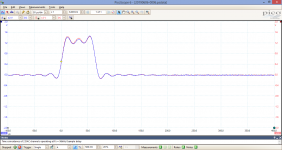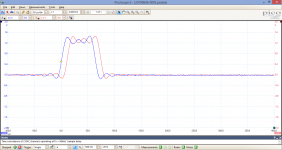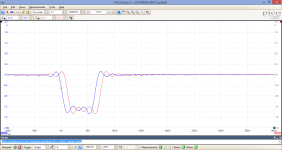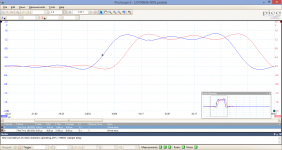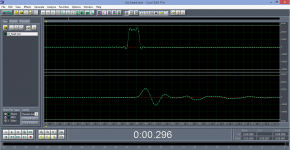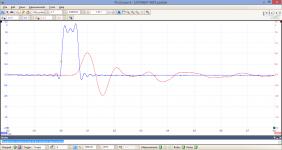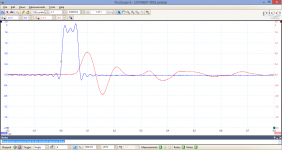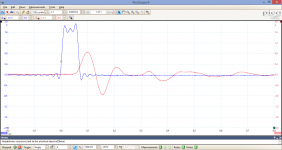You must be new to audio electronics. Here you go. Enjoy your trip.Ok....you wanna dance? 😀
Why does one need to not know what he’s hearing to make an informed decision? Subjectivity can certainly be objective if you train your brain to act impartially......I could give two turds less what it is, if it sounds better to me than better it is!
Cost,pedigree,awesome reviews mean absolutely nothing to me......for example I’m boxing up a Hint right now because my lowly Yamaha sounds better! Now I’m hoping it’s fixable as I really hear the potential it has....but if it comes back from repair still blah and untimely then down the road it goes.
I don’t understand why all this blind testing is even a ‘thing’ ....let your ears and your brain guide your own opinion......if that’s not too foreign a concept? 🙂
Bob
That's stretching the definition of vertical information. Clues about space can be in the recording of course, but to perceive vertical placement, other than specific binaural recordings, the sound needs to be coming from that direction, whether that be by speaker placement, directivity or reflections.So the vertical information can be in the recording depends on how it is captured.
Last edited:
Clues about space can be in the recording of course, but to perceive vertical placement, other than specific binaural recordings, the sound needs to be coming from that direction, whether that be by speaker placement, directivity or reflections.
Of course, with two speakers in horizontal it is easier to engineer L/R image. Also with mono it is easier to perceive depth (when the information is in the recording). But look at headphones, it is not perfect but it can capture 3D information even tho all sound coming from the same direction. The ears do not fully care about the direction, it only cares about the chunk of sound information. By this mechanism, ears can be fooled or confused, because it HAS TO judge where the sound source is even if the information is not there.
Nope, not new at all......over 40 yrs sperience!
You seem to have everyone lumped into some sort of ‘idiot’ category that doesn’t agree.
Last edited:
I don’t understand why all this blind testing is even a ‘thing’ ....let your ears and your brain guide your own opinion......if that’s not too foreign a concept? 🙂
Bob
Exactly, your opinion and nothing more. And maybe you like the Yamaha because your used to it, not that it's better or worse or even sounds different. And your opinion is not proof and either is anyone else's even if they been pushing it on people for 50 years.
I don’t understand why all this blind testing is even a ‘thing’ ....let your ears and your brain guide your own opinion......if that’s not too foreign a concept? 🙂
Bob
If you've ever worked in science, you would know why. Sighted / white box impressions are worse than useless, they are often misleading.
Let me give you a brief example. I recently helped conduct a quick survey of subjective image quality comparing a prototype endoscope to 3 competitors on the market. We have gathered data informally before this, and the results are almost always biased when the surgeon knows what scope captured what images. And these are side-by-side image comparisons, it is VERY easy compared to audio A/B testing. Further, when tuning parameters (just like your optometrist) we do not like to let the participant know what settings we adjusted. If they know sometimes they will ask for further adjustments based on perceived expected outcomes. It's the reason you get the whole "better 1 or 2" at a phoropter. Sometimes we get subjects that falsely perceive a visual difference even though we did not actually change a setting, we only told them we did. Again, these are visual comparisons, with some of them done off-line side-by-side with no time constraint and generally very noticeable differences.
This happens in smartphone camera reviews, you're starting to see blind polls comparing the images because people are biased against brands for various reasons. Huawei, OnePlus, and Xiaomi phones will suffer compared to a Google Pixel or iPhone if the person doing the comparison knows what phone took the pics beforehand.
Last edited:
If you've ever worked in audio, you would know audio (hifi) is not a science.If you've ever worked in science, you would know why. Sighted / white box impressions are worse than useless, they are often misleading.
It is an art(artifact) to create illusions. That use technology, just like David Copperfield.
Don't it seem-you reasonable to judge if an illusion is working with your senses ?
Like all the pure objectivists, you seem to be totally off topic.
it is not because an amp has low distortion that it sound good. It is because we noticed that, most of the time, amps that sound good were low distorted that we build low distortion amplifiers. The goal is not the distortion level, but how it sounds. Will you never understand that ?
Last edited:
If you've ever worked in audio, you would know audio (hifi) is not a science.
It is an art(artifact) to create an illusion.
Don't it seem-you reasonable to judge if an illusion is working with your senses ?
Like all the pure objectivists, you seem to be totally off topic.
No, it's exactly the same thing, it's not my fault you're clueless. Maybe you should leave your ivory tower and work in the real world.
Don't worry, I am already anticipating your very long and verbose reply consisting of sentences that make no sense.
Last edited:
This is, if anything; entertaining.....lol
Try starting reading from here and afterwards let me know if you feel the same...and BTW, welcome! Hope you have thick skin!
Cheers,
Howie
Tourny,
Who is the better artist, Rembrandt or Picasso?
Sorry to read above you have no experience in the audio biz! 😉
Who is the better artist, Rembrandt or Picasso?
Sorry to read above you have no experience in the audio biz! 😉
I kindly enjoy being clueless 😛
If you don’t expect anything then you can trust your perception to be pure, at least I can.
maybe that’s the disconnect.......Y’all think it’s impossible not to be influenced by some self imposed bias.
I’ve been just about legally blind since childhood and to tell you the truth I treat audio just like it was an eye test. good, better, worse, same ....shooting for the middle ground.....I’m glad you brought up that reference.
Bob
Thanks Howie,
Yeah buddy......I’ve been in way tougher crowds than this!
If I liked the Yamaha I wouldn’t have bought the parasound......now I thoroughly expected the Hint to wipe the floor with the Yamaha so by scientific rules it should have sounded better whether it actually did or not?
Go figure....ears and brain beat out the self imposed bias?
If you don’t expect anything then you can trust your perception to be pure, at least I can.
maybe that’s the disconnect.......Y’all think it’s impossible not to be influenced by some self imposed bias.
I’ve been just about legally blind since childhood and to tell you the truth I treat audio just like it was an eye test. good, better, worse, same ....shooting for the middle ground.....I’m glad you brought up that reference.
Bob
Try starting reading from here and afterwards let me know if you feel the same...and BTW, welcome! Hope you have thick skin!
Cheers,
Howie
Thanks Howie,
Yeah buddy......I’ve been in way tougher crowds than this!
Exactly, your opinion and nothing more. And maybe you like the Yamaha because your used to it, not that it's better or worse or even sounds different. And your opinion is not proof and either is anyone else's even if they been pushing it on people for 50 years.
If I liked the Yamaha I wouldn’t have bought the parasound......now I thoroughly expected the Hint to wipe the floor with the Yamaha so by scientific rules it should have sounded better whether it actually did or not?
Go figure....ears and brain beat out the self imposed bias?
I like being clueless too! But I have another hobby, which is making advanced analog circuitry. Mostly it starts from scratching symbols on a napkin (I have been accused of this by wives and others for more than 50 years) trying to put them together in a more useful way, knowing that each symbol has rules, just like Chess pieces do. After years of trying, sometimes something comes up that is even potentially patentable.
So 50+ years ago, I came up with the complementary differential bipolar input stage. Yes, it took more parts than usual, but it measured pretty darn good. I remember measuring less than .005% SMPTE IM at 1W, (104dB with my Khorn). Who needs anything more? Yet, in a direct A-B test with a quality triode amp, the triode sounded better to everybody. What a comedown. I had tested my amp for DF, bandwidth, and it was operating Class A to 4W, and it had 100% stability with any cap load. It still sounded better than my Dyna Mk3 Ultralinear design, but I wanted it to sound as good or better than anything. What did I do wrong? To save unnecessary speculation, I had OVERCOMPENSATED the amp for stability, and I killed the slew rate, which could have been 10times higher or so. I fixed this over time, but it still was not all that I have learned over the decades. Today, I use a similar topology, but usually with jfets on the input that (due to reduced Gm) automatically improves the slew rate, due to needing a smaller comp cap for the same stability. Of course bipolar with emitter degeneration resistors could do the same thing, but they make a little extra noise, and kill some of the global feedback, so GAS when they made a similar circuit, bypassed their resistors with electrolytic caps to get the gain back. Too bad. Within a year or so, Matti Otala started contributing to the IEEE Audio group, and then I learned a lot more. Today, I am still working at the problem, but I have made progress since then.
So 50+ years ago, I came up with the complementary differential bipolar input stage. Yes, it took more parts than usual, but it measured pretty darn good. I remember measuring less than .005% SMPTE IM at 1W, (104dB with my Khorn). Who needs anything more? Yet, in a direct A-B test with a quality triode amp, the triode sounded better to everybody. What a comedown. I had tested my amp for DF, bandwidth, and it was operating Class A to 4W, and it had 100% stability with any cap load. It still sounded better than my Dyna Mk3 Ultralinear design, but I wanted it to sound as good or better than anything. What did I do wrong? To save unnecessary speculation, I had OVERCOMPENSATED the amp for stability, and I killed the slew rate, which could have been 10times higher or so. I fixed this over time, but it still was not all that I have learned over the decades. Today, I use a similar topology, but usually with jfets on the input that (due to reduced Gm) automatically improves the slew rate, due to needing a smaller comp cap for the same stability. Of course bipolar with emitter degeneration resistors could do the same thing, but they make a little extra noise, and kill some of the global feedback, so GAS when they made a similar circuit, bypassed their resistors with electrolytic caps to get the gain back. Too bad. Within a year or so, Matti Otala started contributing to the IEEE Audio group, and then I learned a lot more. Today, I am still working at the problem, but I have made progress since then.
Then why did you ask the following about something as basic as connecting speaker wires? Unless you were joking.Nope, not new at all......over 40 yrs sperience!
I don’t understand why all this blind testing is even a ‘thing’
I mentioned "new" because you asked a question that a novice person would ask. How do you come up with 'idiot' from that?You seem to have everyone lumped into some sort of ‘idiot’ category that doesn’t agree.
Your first question killed-me !Tourny,
Who is the better artist, Rembrandt or Picasso?
Sorry to read above you have no experience in the audio biz! 😉
About the second part, maybe you and I should do a training course with this high-flying teacher ? Not sure that we will learn much, but we will surely laugh a lot.
Then why did you ask the following about something as basic as connecting speaker wires? Unless you were joking.
I mentioned "new" because you asked a question that a novice person would ask. How do you come up with 'idiot' from that?
I don’t even know what you mean by the first part unless your referencing where I mentioned going from a dsp based low pass on the sub to analog and didn’t realize for a bit what was wrong with the phase and had to swap polarity?
The article you told me to enjoy painted those who didn’t follow a certain way of thinking as ‘audiophools’ it was less work to type ‘idiot’
Then read again.I don’t even know what you mean by the first part
Did you finish all 3 links?The article you told me to enjoy painted those who didn’t follow a certain way of thinking as ‘audiophools’ it was less work to type ‘idiot’
It's not certain way of thinking. Those are scientific facts and they can be supported by measurements. Before you doubt the sensitivity of audio measurements, contemporary audio measuring tools can measure sounds that are far beyond (above and below) what human ears can detect.
I like being clueless too! But I have another hobby, which is making advanced analog circuitry. Mostly it starts from scratching symbols on a napkin (I have been accused of this by wives and others for more than 50 years) trying to put them together in a more useful way, knowing that each symbol has rules, just like Chess pieces do. After years of trying, sometimes something comes up that is even potentially patentable.
So 50+ years ago, I came up with the complementary differential bipolar input stage. Yes, it took more parts than usual, but it measured pretty darn good. I remember measuring less than .005% SMPTE IM at 1W, (104dB with my Khorn). Who needs anything more? Yet, in a direct A-B test with a quality triode amp, the triode sounded better to everybody. What a comedown. I had tested my amp for DF, bandwidth, and it was operating Class A to 4W, and it had 100% stability with any cap load. It still sounded better than my Dyna Mk3 Ultralinear design, but I wanted it to sound as good or better than anything. What did I do wrong? To save unnecessary speculation, I had OVERCOMPENSATED the amp for stability, and I killed the slew rate, which could have been 10times higher or so. I fixed this over time, but it still was not all that I have learned over the decades. Today, I use a similar topology, but usually with jfets on the input that (due to reduced Gm) automatically improves the slew rate, due to needing a smaller comp cap for the same stability. Of course bipolar with emitter degeneration resistors could do the same thing, but they make a little extra noise, and kill some of the global feedback, so GAS when they made a similar circuit, bypassed their resistors with electrolytic caps to get the gain back. Too bad. Within a year or so, Matti Otala started contributing to the IEEE Audio group, and then I learned a lot more. Today, I am still working at the problem, but I have made progress since then.
You're going to post that, but you won't even poo poo our new amp using 4 transistors for the front end (BJT no less)!
I'm not surprised the Khorn's were preferred with a boat load of 2nd harmonics. Plus with less feedback the Khorn probably was louder sounding, since the drivers were free to do their thing, as that type of speaker intends. They aren't tuned for high damped amps. Lots of feedback tends to make them sound quiet, and maybe no bass.
To fulfill your request, I made an other listening (one time) with headphones.
This time, apart the difference of tonaly, I was able to "feel" a little difference in spatial position. The lowest tone sometimes on the left and sometimes on the right. But it falls into my category "If it's not an illusion, it does not matter enough to worry.". Only very little angle, if any.
I would have liked longest signals. If I have some time, I will edit them.
Was-it a test to evaluate our thresholds of phase localisation ?
Thank you for participating in the test. To answer your question, I would say maybe. Yes, it was initiated by the cable-induced ITD discussion. I created 3 groups of 3 impulses in each, #1 are L/R coincident, #2 have R channel delayed by 1 sample (10.42 us) behind L channel and #3 R channel ahead of L channel by 1 sample, this means that there is a 20 us difference between #2 and #3. Then I created inversion of these 3 groups, because of those absolute polarity discussions. The test file is in 96kHz/16bit format and measured plots from my DAC output are attached for group #1, #2 and #4 impulses. This is about the signal.
What we hear might be questionable. First, we must be sure that our system does not re-sample the signal, which may easily happen in Windows. I am afraid that only a measurement at DAC output gives an answer. Second, what will be acoustical output from our transducers (headphones, speakers)? They are in no way able to reproduce the impulse shape, even headphones are unable to do the job. In case of speakers, room reflections will be added to the speaker bad time response. Will the transducer be able to give same time response to the positive and negative impulse? And what about our ear, how it responds to the impulse train? Is not the perception of 2nd and 3rd impulse different from that of the 1st one? Literature supports that it is different.
And we know that localization of the impulse source is not only about ITD, but also about ILD (time, level). At least the level in the test signal is kept stable enough. The rest is on our sound system, transducers and ears.
P.S.: The last plot shows headphone response to the test impulse.
Attachments
Last edited:
Are you sure "3 impulses in one group are all same.".....the first set of three sounds different ABA maybe, third group has different order like BAB or something.
These are faint differences on headphones, I will try speakers tomorrow.
Well again - yes I am. Attached is an acoustical measurement of 3 successive impulse from group #1. Blue trace is electric path - DAC output, red trace is microphone measurement of headphones output. It can be seen that even the headphones impulses are consistent, though the headphones time response is unable to follow the electrical impulse shape. It is our ear that makes a different perception of the 1st, 2nd and 3rd incoming impulses. In groups #2 and #3, added interchannel time delay again changes perceived impulse timbre.
Attachments
I measured the K-horn's (corner type) distortion and it was relatively low, certainly lower than most typical direct radiator speakers. Of course, there is the possibility of horn throat distortion, but not much at these operating levels. My amp was like 10-15W, which gave about 115dB before the amp actually clipped. Distortion rise was monotonic, rising to 0.1% near 10W. The triode amp did almost the same distortion with level, and had the same damping factor (about 25) as I remember. I measured it as well.
Speculation by others is not going to give much data. You really have to have been there.
Actually the listening levels we tested were around 1W on peaks. This was 0.005% IM on either amp or less. Unfortunately, back 50 years ago, SMPTE IM was the standard test for amps. Harmonic residual distortion from HP oscillators, and just about everybody else was too high in those days. I don't know when the HP339 was introduced, but I was able to easily harmonic test about 5 years later, when I got my first ST1700B. I use the HP339 as my usual tester, today, with an added HP3563 for FFT of the residual. I only use the SR-1 for special tests. It is just too hard to set up for general measurements.
Speculation by others is not going to give much data. You really have to have been there.
Actually the listening levels we tested were around 1W on peaks. This was 0.005% IM on either amp or less. Unfortunately, back 50 years ago, SMPTE IM was the standard test for amps. Harmonic residual distortion from HP oscillators, and just about everybody else was too high in those days. I don't know when the HP339 was introduced, but I was able to easily harmonic test about 5 years later, when I got my first ST1700B. I use the HP339 as my usual tester, today, with an added HP3563 for FFT of the residual. I only use the SR-1 for special tests. It is just too hard to set up for general measurements.
- Status
- Not open for further replies.
- Home
- Member Areas
- The Lounge
- John Curl's Blowtorch preamplifier part III
